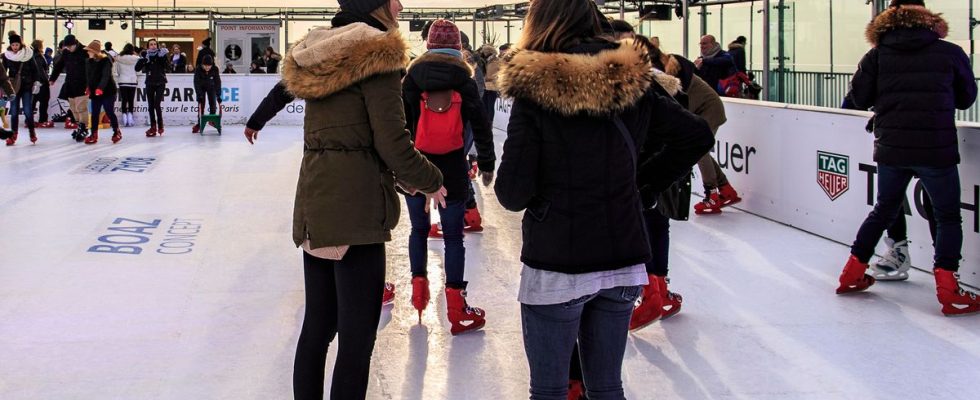This winter, we will have less regrets about putting on our skates. More and more municipalities are opting, for their Christmas events, to install a synthetic ephemeral ice rink, rather than a traditional ice rink. And that changes everything. Because this new type of equipment has a serious advantage: it has a plastic surface, and consumes… nothing. Whereas an icy expanse, very sensitive to the outside temperature, is a real energy sinkhole. Even more so with global warming, where we have to raise the thermostat a little more, so that the ice does not melt. For municipalities, a synthetic ice rink is the guarantee of not spending a cent on water and electricity. And what’s more, it’s a way of being eco-friendly.
For the first time, this year, the town hall of Nîmes (Gard) has chosen to install, on the square in front of the arenas, from December 22 to January 7, a synthetic ice rink. “We have increasingly mild Decembers at home,” confides Frédéric Pastor, the elected official in charge of the festivities, to 20 minutes. This required us to turn the turbines on full blast, to prevent the ice from melting. So in terms of energy costs, traditional ice rinks were far, far beyond what was best done. »
“We’re saving the planet!” »
And what’s more, with a synthetic ice rink, “we’re saving the planet”, smiles the deputy mayor. “We are ecologically committed, we use LED lights for illumination, we use recycled material, etc.,” adds Frédéric Pastor. Besides that, we could not continue to install an energy-intensive ice rink. A synthetic ice rink is certainly not real ice. Skids are a little different. But it’s very nice, it reproduces the sensations of a traditional ice rink well. »
The Lille company Boaz Conceptspecializing in the rental and sale of leisure equipment, has seen demand for synthetic rinks jump in recent years, confides to 20 minutes its president and director of development, Arnaud Comyn. “Even the municipalities which were the most convinced by traditional ice no longer allow themselves to do so, or less and less, because they are singled out by their citizens, at a time when energy savings are being advocated,” explains the entrepreneur, whose teams notably took up the challenge of installing a synthetic ice rink at the top of the Montparnasse Tower, in Paris. “It is, clearly, the future,” assures Arnaud Comyn.
A “self-lubricated” surface, thanks to an innovative gel
According to this expert, one euro invested in the installation of a traditional ice rink is equivalent to approximately one euro in energy costs. For an ice rink old school rented for 80,000 euros, this is the guarantee of receiving a bill for 80,000 euros for electricity, he confides. At least. Whereas with a plastic rink, the rental price is roughly equivalent, but the energy costs are… 0.
But, actually, how… do you slide on plastic? The synthetic rinks deployed for many years by the company Boaz Concept are made with PEHD-1000 (High Density Polyethylene), “which looks a bit like the material from which cutting boards are made, which we use for kitchen, details its president. It’s a very, very dense material.” And the big plus is that this surface is “self-lubricated”, thanks to an innovative gel, with which the rink plates are impregnated. Thus, “as the users’ skates shear this synthetic ice, it becomes even more slippery,” explains Arnaud Comyn.
For the feeling to be optimal, the skates must be sharpened regularly.
So yes, recognizes the president of the Lille company, it can happen that skating lovers are a little disappointed when using this synthetic equipment. Yes, obviously, it’s not ice cream. But there is another reason for this disappointment: ice skates must be regularly sharpened for optimal gliding. On a polyethylene ice rink, “the sharpening is lost, in fact, much more quickly, because the sliding coefficient is less important than on natural ice,” explains the entrepreneur from the North. It is therefore very important to provide sharpeners, to re-sharpen the skates, at least every two to three skaters, so that the pleasure of skating, if not necessarily equivalent, is really very, very pleasant. . »
To convince municipalities (and skaters), manufacturers of synthetic ice rinks even try to imitate the appearance of traditional equipment, by opting for slightly bluish surfaces, which imitate natural ice. “When we build ecological rinks, curious people sometimes come and touch the material, wondering if it’s real ice or not! », laughs Arnaud Comyn. “The best is when a little icy rain falls, so it’s really amazing! »

